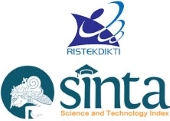Determination Of The Feasibility of Tourism Villages In West Manggarai Regency
Abstract
ABSTRACT
The purpose of this study is to assess the readiness of the two villages proposed by the Regional Government of West Manggarai Regency (Wae Sano and Wae Lolos Villages) as a tourism village using an instrument compiled through focus group discussions with stakeholders in the field of tourism village development. Therefore, the local government intend to promoting cultural attraction as an effort to reduce negative impacts at Labuan Bajo and at the same time equalize the positive impacts of tourism. The approach of quantitative descriptive method was used on data obtained through focus group discussions and observations to test the readiness of a village to become a tourist village. The data analysis technique uses the interval interpretation technique, in which there are three interval categories. The results of this study indicate that there are six variables assessed in the tourism village assessment instrument, namely 1) attractions (nature and culture), 2) accessibility, 3) amenities (public facilities and tourism support), 4) institutions and society, 5) strategy. marketing, and 6) industry. Based on the results of the study, it can be concluded that the Wae Sano villages and Wae Lolos villages can be included in the category "can be recommended to become a tourist village with a note". This is due to records in several aspects, such as amenities, marketing strategies, and industry in the two villages.
Keywords: Amenities, Cultural Attractions, Institutional and Community, Tourism Village Determination, West Manggarai,
Keywords
Full Text:
PDFReferences
Akrida, I. N. S. & Punjani, L. P. K. (2017). Kajian Penyusunan Kriteria-Kriteria Desa Wisata Sebagai Instrumen Dasar Pengembangan Desa Wisata. Jurnal Analisis Pariwisata. 17(1).
Amerta, I. M. S. (2017). The role of tourism stakeholders at Jasri tourism village development, Karangasem regency. International Journal of Social Sciences and Humanities (IJSSH), 1(2), 20-28.
Ayazlar, G. & Ayazlar R. A. (2015). Rural Tourism: A Conceptual Approach. Tourism, Environment and Sustainability. Sofia: St. Kliment Ohridski University Press
Badan Pusat Statistik. (2018). Jumlah Devisa Sektor Pariwisata (Miliar US $), 2016-2018
Hadiwijoyo, S.S. (2012.). Perencanaan pariwisata perdesaan berbasis masyarakat: (sebuah pendekatan konsep). Yogyakarta: Graha Ilmu.
Kementerian Pariwisata. (2019). Buku Pedoman Desa Wisata. Edisi I.
Khandare, V., & Phophueksanand, N. (2018). Social and Cultural Impact of Tourism Development in Thailand. International Journal of Research in Economics and Social Sciences, 8(2), 877-887.
Leonandri, D., & Rosmadi, M. L. N. (2018). The role of tourism village to increase local community income. Budapest International Research and Critics Institute (BIRCI-Journal): Humanities and Social Sciences, 1(4), 188-193.
Nuryanti, W. (1993). Concept, Perspective and Challenges. Makalah bagian dari Laporan Konferensi Internasional mengenai Pariwisata Budaya. Yogyakarta: Gadjah Mada University Press.
Peraturan Menteri Dalam Negeri Nomor 18 Tahun 2018. Lembaga Kemasyarakatan dan Lembaga Adat Desa. 9 April 2018. Berita Negara Republik Indonesia Tahun 2018 Nomor 569. Jakarta.
Peraturan Menteri Kebudayaan dan Pariwisata Nomor KM.18/HM.001/MKP/2011. Pedemoman Umum Program Nasional Pemberdayaan Masyarakat (PNPM) Mandiri Pariwisata Melalui Desa Wisata. 13 Maret 2012. Berita Negara Republik Indonesia Tahun 2012 Nomor 197. Jakarta.
Pusparani, Y. (2019, September). Perencanaan Destination Branding Melalui Mural di Desa Wisata, Desa Sumber Harapan, Kalimantan Barat. In Sandyakala: Prosiding Seminar Nasional Seni, Kriya, dan Desain. (Vol. 1, pp. 353-363).
Franisal, P. N. (2020). Analysis of Homestay Criteria Compliance in Tourist Village According to the Visitor's Perception. TRJ Tourism Research Journal, 4(2), 133-149.
Gundolf, K., & Jaouen, A. (2005). Patterns and coordination of collective action in small and very small business: the case of a tourist village in the Pyrenees. International Journal of Entrepreneurship and Small Business, 2(4), 392-403.
Hidayatullah, S., Rachmawati, I. K., Khouroh, U., & Windhyastiti, I. (2017, August). The Effectivity of “Pokdarwis” Role on Successfully Marketing of Tourism Village Towards “Mega Tourism: Batu City For The World”. In International Conferences SDGs 2030 Challenges and Solutions (Vol. 1, No. 1).
Komariah, N., Saepudin, E., & Rodiah, S. (2018). Development of tourist village based on local wisdom. Journal of Environmental Management & Tourism, 9(6 (30)), 1172-1177.
Muganda, M., Sirima, A., & Ezra, P. M. (2013). The role of local communities in tourism development: Grassroots perspectives from Tanzania. Journal of Human Ecology, 41(1), 53-66.
Sharafieva, D. R. (2012). Funktsii turizma v sotsialno ekonomicheskoy structure obschestva. Известия Казанского государственного архитектурно-строительного университета, (4 (22)), 78-86.
Telfer, D. & R. Sharpley. (2008). Tourism and Development in the Developing World. London: Routledge.
United Nations World Tourism Organization. Rural And Mountain Tourism. Diunduh pada 10 desember 2020 dari https://www.unwto.org/rural-mountain-tourism.
Williams, C. (2007). Research Methods. Journal of Business & Economic Research. 5(3).
World Travel & Tourism Council. (2020). Travel & Tourism: Global Economic Impact & Trends 2020.
Yoeti, Oka. (1996). Pengantar Ilmu Pariwisata. Bandung: Angkasa
DOI: https://doi.org/10.17509/jithor.v4i1.32004
Refbacks
- There are currently no refbacks.

This work is licensed under a Creative Commons Attribution-ShareAlike 4.0 International License.
eISSN : 2654-4687
pISSN : 2654-3893
This work is licensed under Creative Commons Attribution-ShareAlike 4.0 International License
Statcounter













